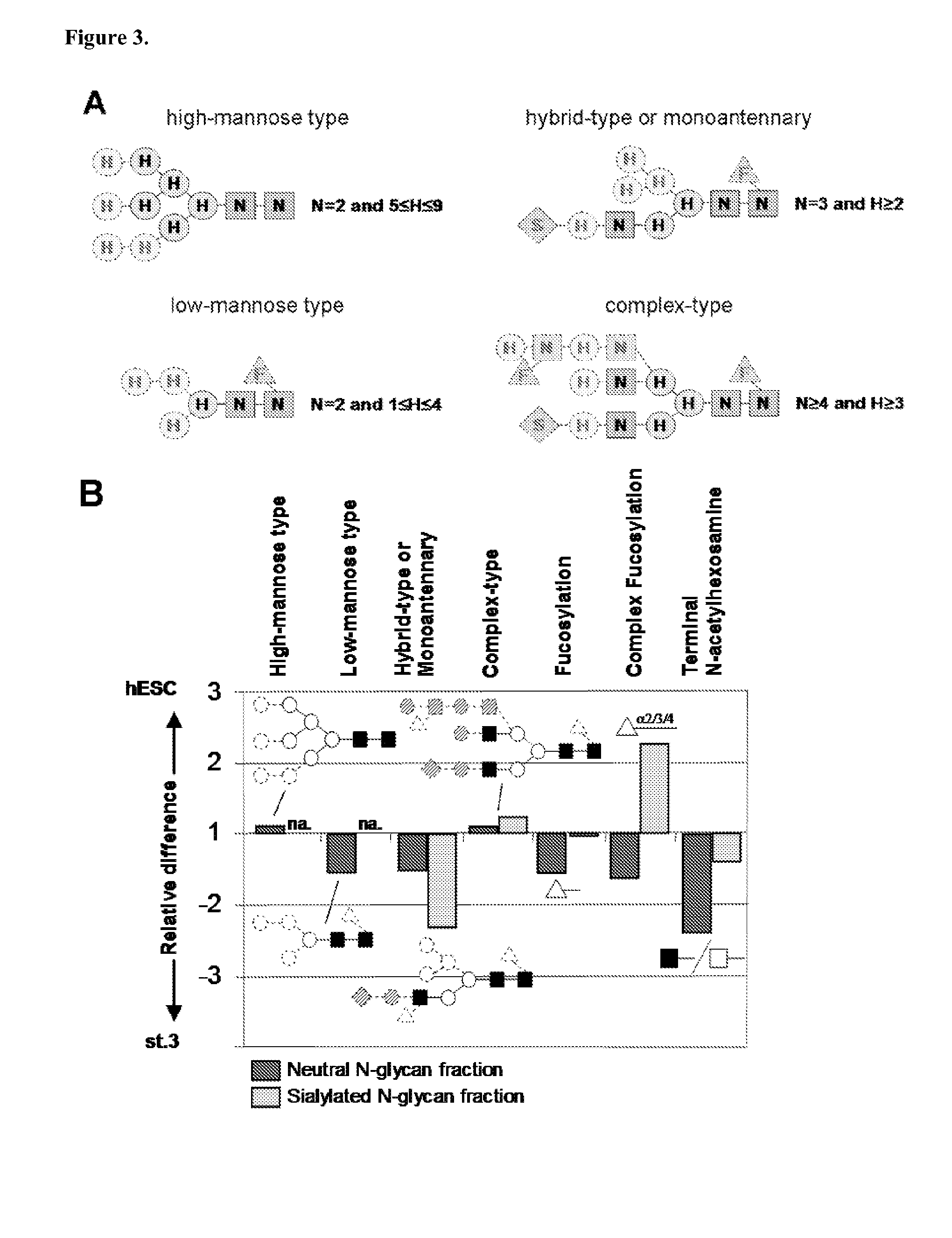Novel cellular glycan compositions
a technology of glycans and compositions, applied in the field of new compositions of glycans and glycomes, can solve the problems of inability to isolate stem cells from organs or peripheral blood, inability to identify and isolate multipotent “embryonic-like” stem cells using known markers,
- Summary
- Abstract
- Description
- Claims
- Application Information
AI Technical Summary
Problems solved by technology
Method used
Image
Examples
example 1
REFERENCES FOR EXAMPLE 1
[1017]1. Shriver, Z., Raguram, S., and Sasisekharan, R. (2004) Nat. Rev. Drug Disc. 3, 863-873
[1018]2. Varki, A. (1993) Glycobiology 3, 97-130
[1019]3. Apweiler, R., Hermjakob, H., and Sharon, N. (1999) Biochim Biophys. Acta 1473, 4-8
[1020]4. Lowe, J. B. (2002) Immunol. Rev. 186, 19-36
[1021]5. Fukuda, M. (2002) Biochim. Biophys. Acta 1573, 394-405
[1022]6. Dell, A., Morris, H. R., Easton, R. L., Patankar, M., and Clark, G. F. (1999) Biochim. Biophys. Acta 1473, 196-205
[1023]7. Fenderson, B. A., Zehavi, U., and Hakomori, S. (1984) J. Exp. Med. 160, 1591-1596
[1024]8. Handel, T. M., Johnson, Z., Crown, S. E., Lau, E. K., and Proudfoot, A. E. (2005) Annu. Rev. Biochem. 74, 385-410
[1025]9. Helenius, A., and Aebi, M. (2001) Science 291, 2364-2369
[1026]10. Helenius, A., and Aebi, M. (2004) Annu. Rev. Biochem. 73, 1019-1049
[1027]11. Kornfeld, S. (1986) J. Clin. Invest. 77, 1-6
[1028]12. Thomson, J. A., Itskovitz-Eldor, J., Shapiro, S. S., Waknitz, M. A., Swiergiel, J. J...
example 2
Analysis of N-Glycan Composition Groups with Terminal HexNAc in Stem Cells and Differentiated Cells
[1073]Methods. To analyze the presence of terminal HexNAc containing N-glycans characterized by the formulae: nHexNAc=nHex≧5 and ndHex≧1 (group I), and to compare their occurrence to terminal HexNAc containing N-glycans characterized by the formulae: nHexNAc=nHex≧5 and ndHex=0 (group II), N-glycans were isolated, purified and analyzed by MALDI-TOF mass spectrometry as described in the preceding Examples. They were assigned monosaccharide compositions and their relative proportions within the obtained glycan profiles were determined by quantitative profile analysis as described above. The following glycan signals were used as indicators of the specific glycan groups (monoisotopic masses):
[1074]Ia, Hex5HexNAc5dHex1: m / z for [M+Na]+ ion 2012.7
[1075]Ib, NeuAc1Hex5HexNAc5dHex1: m / z for [M−H]− ion 2279.8
[1076]Ic, NeuAc2Hex5HexNAc5dHex1: m / z for [M−H]− ion 2570.9
[1077]Id, NeuAc1Hex5HexNAc5dHe...
example 3
Evaluation of Individual Variation in Relative Proportions of N-Glycan Signals of hESC Lines
[1082]The propensity of each glycan signal to be subject to individual variation between cell lines was estimated by calculating the average deviation of the glycan signal relative proportions between the four hESC lines. The deviations were then evaluated as proportion of average deviation from the average signal proportion (in %). In this calculation, three groups of glycan signals were obtained: over 100% average deviation (large individual variation), between 50-100% average deviation (substantial individual variation), and between 0-50% average deviation (little individual variation). Below are the glycan signals listed in Tables 1 and 2 as grouped according to this.
[1083]Over 100% (large individual variation):
[1084]Neutral N-glycans H4N3F2, H5N5, H4N5, H4N5F2, H4N4F2, H6N4, H4N5F1, H5N5F1, H3N5, H2N4F1, H4N4, H4N5F3, H2N2, H3N5F1, H5N2F1, and H6N3F1.
[1085]Sialylated N-glycans S2H7N6F1, ...
PUM
| Property | Measurement | Unit |
|---|---|---|
| core structure | aaaaa | aaaaa |
| anomeric structure | aaaaa | aaaaa |
| end elongation | aaaaa | aaaaa |
Abstract
Description
Claims
Application Information
 Login to View More
Login to View More - R&D
- Intellectual Property
- Life Sciences
- Materials
- Tech Scout
- Unparalleled Data Quality
- Higher Quality Content
- 60% Fewer Hallucinations
Browse by: Latest US Patents, China's latest patents, Technical Efficacy Thesaurus, Application Domain, Technology Topic, Popular Technical Reports.
© 2025 PatSnap. All rights reserved.Legal|Privacy policy|Modern Slavery Act Transparency Statement|Sitemap|About US| Contact US: help@patsnap.com



